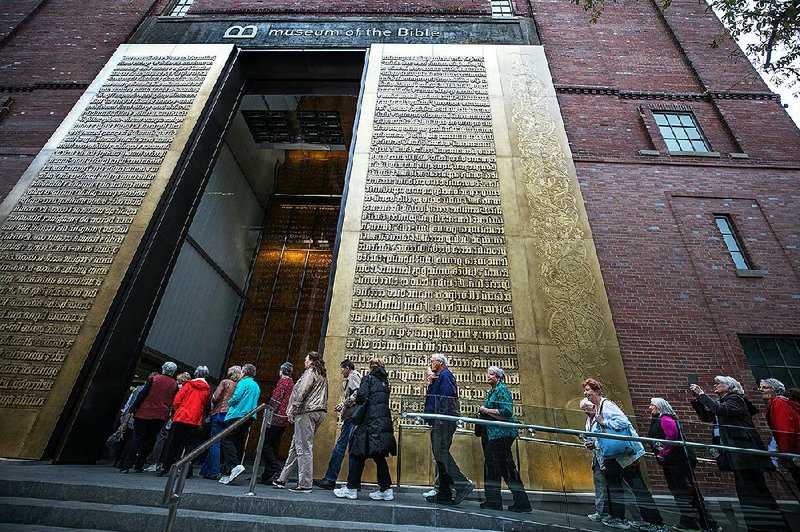WASHINGTON — After two years and 2 million visitors, the Museum of the Bible is launching new programs aimed at increasing attendance and deepening its connection with its audience.
Starting this month, the nonprofit museum — funded primarily by the evangelical Green family, owners of the Hobby Lobby chain of craft stores — will present performances and temporary exhibitions that focus on Christmas, Passover, black spirituals and more.
The initiative is the work of arts management guru Michael Kaiser, former head of the Kennedy Center and chairman of the DeVos Institute of Arts Management at the University of Maryland. Kaiser is helping the institution’s senior executives — who have almost no museum experience — to transition from getting open to staying open.
“Michael really challenged us to say, ‘You built it, now what do you do with it?’” said Ken McKenzie, a 38-year veteran of the aviation industry who became the museum’s chief executive last November.
Harry Hargrave, a Dallas real-estate executive who helped the nonprofit museum secure its location just blocks from the Capitol, will take over in the executive role from McKenzie on Thursday.
When the $500 million museum opened a few blocks from the Capitol on Nov. 17, 2017, demand was so high that free passes were required. It attracted 1 million visitors just a few days after its first anniversary, officials said. Starting in December, it altered its admission policy from suggested donation to required tickets, which are $24.99 for adults and $14.99 for children ages 6 to 17 (with a $5 discount per ticket if bought online). Despite this change, officials say that attendance this year has remained around the 1-million mark.
Those numbers lag behind other museums in Washington, including the most popular, the Smithsonian’s National Air and Space Museum, which draws upward of 6 million visitors annually. The Smithsonian’s National Museum of African American History and Culture, which opened three years ago, has welcomed more than 5 million visitors. The National Portrait Gallery — which, like the Bible museum, is near a Metro stop but not on the National Mall — has drawn more than 2.8 million visitors since the start of 2018.
The museum has had its share of critics, some who object to its promotion of the conservative Christian views of its benefactor, the family behind the company that won a U.S. Supreme Court decision in a lawsuit over a federal requirement that it provide contraceptives to its employees. Others take issue with what they consider the museum’s narrow view of the Old Testament, and with the absence of Islam and Mormon traditions in its galleries.
Kaiser was brought on earlier this year by Dick DeVos, an heir to the Amway fortune, who with his wife, Secretary of Education Betsy DeVos, supports the museum and Kaiser’s arts management institute.
“We’d like him to help you with strategy,” McKenzie said Dick DeVos told him soon after he started at the museum. He immediately agreed. “[Kaiser] has challenged us, challenged our way of thinking.”
Under Kaiser’s guidance, the museum is moving from start-up phase to mature organization. It has hired its first chief marketing and chief development officers and brought on a director of exhibits from the U.S. Holocaust Memorial Museum. The goal is to build programs that will attract 25% more visitors and increase memberships and donations. The Greens still back the museum, McKenzie said, but there is a need to broaden support.
Boosting loyalty is the key to growth, Kaiser said.
“It’s a question of what is going to make [visitors] come back,” Kaiser said. “It’s important because they aren’t going to be involved, financially or in a deep way, unless they (do).”
The Christmas holiday will be emphasized as a new tradition for its visitors, officials said.
“No one owns Christmas in D.C.,” McKenzie said. “And what better place? If you can’t do it here, you can’t do it anywhere.”
This Christmas season, the museum will launch a modest celebration with a Canadian Brass concert Dec. 19. In years to come, it will showcase how the holiday is celebrated in different cultures.
Special exhibitions, the purview of chief curatorial officer Jeffrey Kloha, are seen as another way to build interest. “A Fence Around the Torah,” which opens this week and runs through March 29, features an ancient Pentateuch — a text of the first five books of the Bible: Genesis, Exodus, Leviticus, Numbers and Deuteronomy. It will be on view to the public for the first time, Kloha said, adding that the museum will post high-resolution images of the text for scholars, too.
“If you want to study it, study it. It’s a tremendously important item, and it’s not for hoarding, it’s for sharing. That’s what museums do,” he said.
An exhibit of woodblock prints from the Vatican Library opened Thursday, and a Passover-theme exhibition in partnership with the Joods Historisch Museum in Amsterdam will open in February.
Three cantors from New York synagogues will perform Jan. 26, and a concert by the Fisk University choir is planned for Feb. 8. The Washington Bach Consort will present an Easter Prelude on March 29, and in early May, the museum will host an inaugural Festival of Choirs competition.

